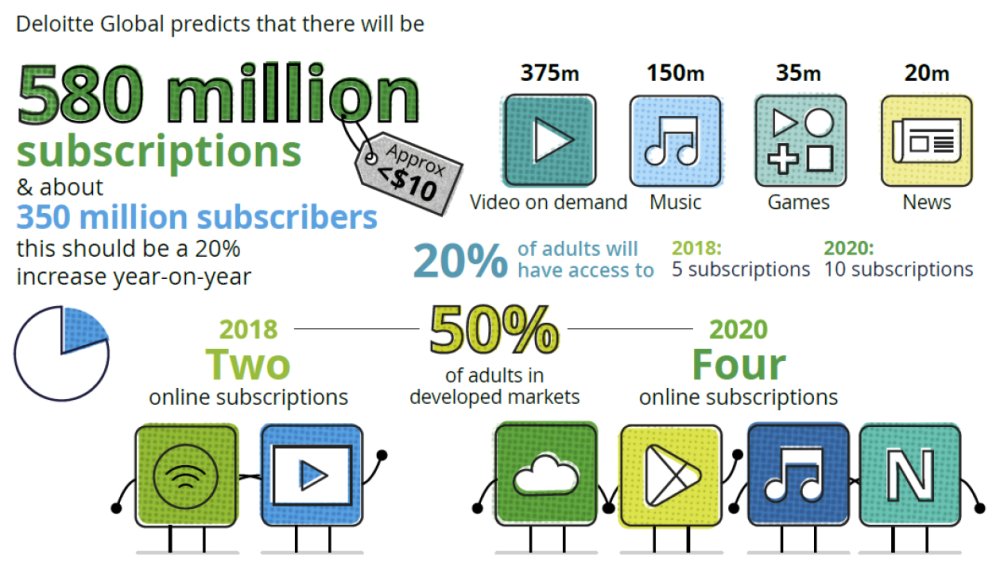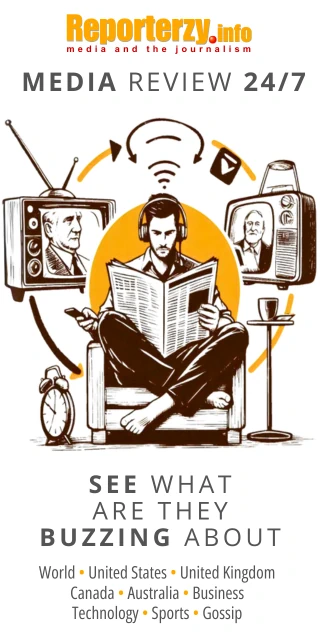 source: Deloitte, TMT Predictions 2018
source: Deloitte, TMT Predictions 2018The TMT Predictions 2018 report by Deloitte experts forecasts that by the end of 2018, half of adults in developed countries will have at least two online media subscriptions, increasing to four by 2020. The cost of these subscriptions, primarily covering television, movies, music, news, and press, will average below $10 per month in 2018. The global subscriber count is projected to reach 350 million people, with 580 million subscriptions, most of which will be VoD (375 million).
Up to 20% of adults in developed countries will subscribe to, or have access to, at least five paid online media subscriptions, and by 2020, this figure could rise to ten.
- "The subscription model has been long known in traditional media, such as print magazine subscriptions. Now, we are witnessing its growing popularity online due to several factors," says Jakub Wróbel, Senior Manager in Deloitte`s Consulting Department. - "The primary drivers are increasingly attractive content available on multiple devices and a growing customer base willing to pay for it."
This trend is also supported by technological advancements and faster internet connections. In Poland, recent years have seen the growth of video services like Netflix, Player.pl, and ShowMax, which also invest in local productions. The trend of "binge-watching," where entire seasons of shows are available at once, allows viewers to spend hours watching on TVs, computers, or phones without interruption.
According to Deloitte’s research, this trend is especially prevalent among millennials, where:
- 90% admit to binge-watching,
- and 38% do so regularly (data from U.S. viewers).
- "As this trend continues, content providers and advertisers will look for ways to leverage it to better reach customers. At the same time, we can expect an increase in content suitable for binge-watching," comments Jakub Wróbel.
The End of Advertising in Media? A Bold Prediction
According to the authors of the "TMT Predictions 2018" report, as media reach increases, revenue per reader, viewer, ad impression, or click is decreasing. Deloitte experts emphasize that, in this situation, some publishers see attempts to generate revenue from online advertising as a waste of time. Consequently, content creators may focus on increasing subscription revenues and creating more varied, audience-specific subscription packages.
This shift is supported by research on ad-blocking trends. Deloitte experts estimate that, by 2018, 10% of adults in North America will engage in at least four simultaneous ad-blocking actions on computers and mobile devices, reflecting a condition known as “ad-phobia.”
Data from 2017 published by Page Fair reveals that:
- Ad-blocking software is installed on 615 million devices worldwide
- 11% of global internet users block ads
- Global ad-block usage increased by 30% in one year
In Poland, ad-block usage reached 33% among internet users in 2017, placing Polish users among the highest in the world for ad-block adoption.
COMMERCIAL BREAK
New articles in section Media industry
Advertising market 2025. Poland, Europe and the World
Marcin Grządka
The global advertising market is growing by 8.8% in 2025 and will reach a value of 1.14 trillion dollars. The industry result in Europe records slightly lower dynamics, at the level of 5.8%. In this comparison, Poland performs clearly above the average. We will record an increase of 8.9% this year and a value of 18.56 billion PLN - estimates WPP Media in the annual report "This Year Next Year".
The print media market 2025. Three global trends
Krzysztof Fiedorek
The market value is 359.53 billion dollars, yet the erosion is visible to the naked eye. The decline for newspapers will amount to -2.3 percent. Despite this, print retains strength: it generates 76 percent of subscription revenues and enjoys 82 percent consumer trust. The future of the industry is defined by hybrid strategies and niche specialization.
Journalism in the age of AI. Why people prefer humans over machines
Krzysztof Fiedorek
Only 12% of people accept news created solely by AI, while 62% prefer those written by humans. At the same time, only 19% notice labels indicating the use of artificial intelligence, while younger audiences ask AI to explain the content to them. These are the findings of the Reuters Institute report on artificial intelligence in media.
See articles on a similar topic:
Most medical influencer posts on TikTok are FALSE
KFi
Researchers from East Carolina University Health Medical Center analysed 120 TikTok videos tagged with hashtags such as #naturalparenting, #antivaccine, and #holistichealth. The results of their study leave no doubt.
Zero-click search 2025. The even bigger end of clicking in search engines
Bartłomiej Dwornik
Google is giving up its role as a web signpost. More and more, it wants to be the destination of the whole journey. ChatGPT and Perplexity are hot on its heels, changing the rules of the search game. AI Overviews is a card from the same deck. Only content creators are losing ground in this race.
Energy under attack. Disinformation threatens Poland’s power transition
KFi
One in five online messages about energy may be fake. Between 2022 and 2025 nearly 70,000 publications warning and condemning disinformation in this strategic sector were recorded in Polish media. They generated a reach of 1.19 billion impressions.
Digital Newspapers in Poland
Bartłomiej Dwornik
The three largest distributors of digital press editions in Poland sell around 270,000 e-magazine copies monthly, according to Money.pl analysis. Digital press is mostly read by experienced internet users, managers, and emigrants.






























